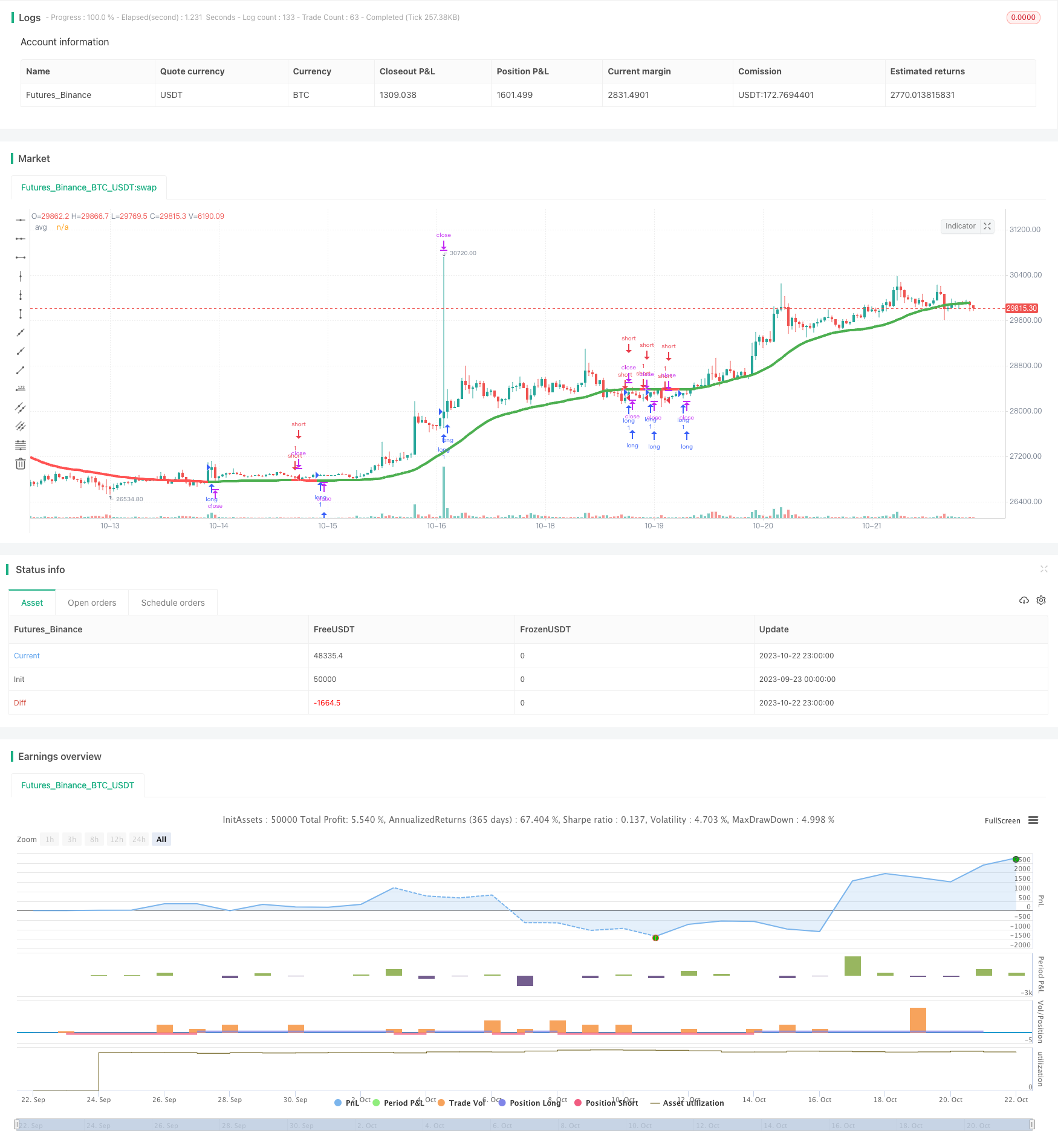Dual Moving Average Cross Market Trading Strategy
Author: ChaoZhang, Date: 2023-10-24 16:55:38Tags:

Overview
This strategy combines the advantages of Hull moving average and T3 moving average to design a cross-market trading strategy. It can be used for both short-term trading and long-term trend tracking. By calculating the mean value of Hull moving average and T3 moving average as the main trading signal line, it determines entry and exit points based on the directional changes.
Strategy Logic
The strategy is mainly based on the calculation of Hull moving average and T3 moving average.
The Hull Moving Average (HMA) uses a weighted moving average iterative calculation method to effectively filter out market noise and display a smooth price trend curve. It is more sensitive to price changes than simple moving averages and exponential moving averages, while also effectively suppressing false breakouts.
The T3 moving average responds faster to price changes while reducing lag by adjusting parameters. Through multiple exponential smoothing calculations, it can quickly respond to price changes.
This strategy takes the average of the two as the main trading indicator. It judges entry timing according to the direction of this average line: if the current period’s average is higher than the previous period, it is a long entry signal; if lower, it is a short entry signal.
For exit rules, if the price breaks through the stop loss or take profit point, exit; also exit when the moving average direction changes.
Advantage Analysis
This strategy combines the advantages of Hull moving average and T3 moving average to generate a comprehensive indicator. Next, this strategy is suitable for both short-term and long-term trading by adjusting the cycle parameter. Also, it adopts dynamic stop loss and take profit to lock in profits and control risks.
Risk Analysis
The strategy relies mainly on the moving average indicator, which may generate multiple false signals in ranging trends. In addition, the lagging of moving averages may miss the best entry timing. The stop loss and take profit points need careful setting to avoid being too loose or too tight. Finally, parameters need optimization for different currencies and timeframes.
Optimization
Consider adding other indicators to verify the MA signal and filter out false signals. Test different MA combinations and weighting algorithms to optimize the MA signal. Add adaptive stop loss and trailing take profit to dynamically manage risks. Conduct backtesting optimization on different currencies and timeframes to find the optimal parameter sets.
Summary
This strategy integrates the strengths of Hull moving average and T3 moving average to form a comprehensive indicator for judging trend direction. Through parameter optimization, the strategy can be flexibly applied to different trading cycles. The strategy has certain advantages but also problems like lagging and false signals. By adding other indicators, optimizing parameters and dynamic stops, it can be continuously improved for better results.
/*backtest
start: 2023-09-23 00:00:00
end: 2023-10-23 00:00:00
period: 1h
basePeriod: 15m
exchanges: [{"eid":"Futures_Binance","currency":"BTC_USDT"}]
*/
// This source code is subject to the terms of the Mozilla Public License 2.0 at https://mozilla.org/MPL/2.0/
// © exlux99
//@version=4
strategy(title="Swing HULL + T3 avg", shorttitle="Swing HULL T3 AVG", overlay=true)
fromDay = input(defval = 1, title = "From Day", minval = 1, maxval = 31)
fromMonth = input(defval = 1, title = "From Month", minval = 1, maxval = 12)
fromYear = input(defval = 2000, title = "From Year", minval = 1970)
//monday and session
// To Date Inputs
toDay = input(defval = 31, title = "To Day", minval = 1, maxval = 31)
toMonth = input(defval = 12, title = "To Month", minval = 1, maxval = 12)
toYear = input(defval = 2021, title = "To Year", minval = 1970)
startDate = timestamp(fromYear, fromMonth, fromDay, 00, 00)
finishDate = timestamp(toYear, toMonth, toDay, 00, 00)
time_cond = true
////////////////////////////GENERAL INPUTS//////////////////////////////////////
length_Ma= input(defval=50, title="Length MAs", minval=1)
//==========HMA
getHULLMA(src, len) =>
hullma = wma(2*wma(src, len/2)-wma(src, len), round(sqrt(len)))
hullma
//==========T3
getT3(src, len, vFactor) =>
ema1 = ema(src, len)
ema2 = ema(ema1,len)
ema3 = ema(ema2,len)
ema4 = ema(ema3,len)
ema5 = ema(ema4,len)
ema6 = ema(ema5,len)
c1 = -1 * pow(vFactor,3)
c2 = 3*pow(vFactor,2) + 3*pow(vFactor,3)
c3 = -6*pow(vFactor,2) - 3*vFactor - 3*pow(vFactor,3)
c4 = 1 + 3*vFactor + pow(vFactor,3) + 3*pow(vFactor,2)
T3 = c1*ema6 + c2*ema5 + c3*ema4 + c4*ema3
T3
hullma = getHULLMA(close,length_Ma)
t3 = getT3(close,length_Ma,0.7)
avg = (hullma+t3) /2
////////////////////////////PLOTTING////////////////////////////////////////////
colorado = avg > avg[1]? color.green : color.red
plot(avg , title="avg", color=colorado, linewidth = 4)
long=avg>avg[1]
short=avg<avg[1]
tplong=input(0.08, title="TP Long", step=0.01)
sllong=input(1.0, title="SL Long", step=0.01)
tpshort=input(0.03, title="TP Short", step=0.01)
slshort=input(0.06, title="SL Short", step=0.01)
if(time_cond)
strategy.entry("long",1,when=long)
strategy.exit("closelong", "long" , profit = close * tplong / syminfo.mintick, loss = close * sllong / syminfo.mintick, alert_message = "closelong")
strategy.entry("short",0,when=short)
strategy.exit("closeshort", "short" , profit = close * tpshort / syminfo.mintick, loss = close * slshort / syminfo.mintick, alert_message = "closeshort")
- RSI EMA Crossover Strategy
- Trend Following Dual Moving Average Strategy
- Glory Hole Breakout Strategy
- Heiken Ashi Moving Average Crossover Strategy with MACD Filter V3
- RSI Cross-Cycle Trading Strategy
- SuperTrend Enhanced Pivot Reversal Strategy
- Momentum Arbitrage Strategy Backtest Analysis
- Mean Reversion Bollinger Bands Strategy
- Linear Regression Moving Average Trading Strategy
- Dual Bandpass Filter Strategy
- Bollinger Band Fitting Strategy
- Bull and Bear Power Backtest Strategy
- Moving Average Crossover Strategy
- Stochastic Momentum Breakout Strategy
- Qullamaggie Breakout V2 Strategy
- Breakout Strategy Based on Camarilla Channels
- Going with the Trend Moving Average Crossover Strategy
- Monthly Trend Breakout Strategy
- DEMA Volatility Index Strategy
- A Trend Following Strategy